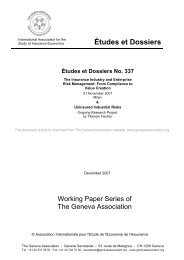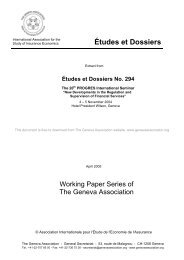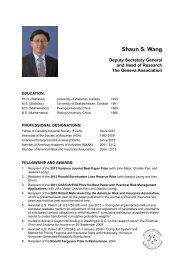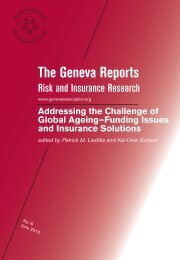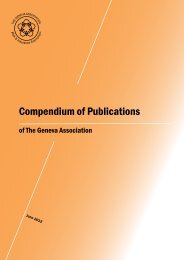Addressing the Challenge of Global Ageing—Funding Issues
Addressing the Challenge of Global Ageing—Funding Issues
Addressing the Challenge of Global Ageing—Funding Issues
Create successful ePaper yourself
Turn your PDF publications into a flip-book with our unique Google optimized e-Paper software.
12<br />
<strong>Addressing</strong> <strong>the</strong> <strong>Challenge</strong> <strong>of</strong> <strong>Global</strong> Ageing—Funding <strong>Issues</strong> and Insurance Solutions<br />
<strong>the</strong> impact <strong>of</strong> insurance products and services (or <strong>the</strong>ir absence) and <strong>the</strong> significance <strong>of</strong><br />
insurers in <strong>the</strong> capital markets.<br />
Liedtke and Trainar point out that insurance contributes close to 7 per cent to global GDP<br />
and is a major employer, for example in Germany and <strong>the</strong> U.S. where <strong>the</strong> sector accounts<br />
for 3.4 per cent and 1.6 per cent <strong>of</strong> all jobs, respectively. They also elaborate in detail on<br />
insurers’ role as major institutional investors and “financial intermediaries, converting<br />
policyholder payments into longer term investments, <strong>of</strong>ten without generating <strong>the</strong> liquidity<br />
constraints facing most deposit taking institutions.” The authors argue that insurance has<br />
a double positive impact on aggregate savings: firstly, it increases <strong>the</strong> general savings<br />
rate, especially through <strong>the</strong> existence <strong>of</strong> life insurance products but also by creating pools<br />
<strong>of</strong> assets that are meant to cover potential future claims. It thus creates deeper markets<br />
and allows for more investments. “The investment portfolio <strong>of</strong> insurance companies in <strong>the</strong><br />
OECD countries has grown steadily over <strong>the</strong> past decade (…). From 2001 through 2008<br />
total investments more than doubled from US$8.6tn to US$17.8tn in 2008 (a compounded<br />
annual rate <strong>of</strong> almost 11 per cent)”, <strong>the</strong> authors explain. Secondly, Liedtke and Trainar<br />
argue, insurance decreases <strong>the</strong> level <strong>of</strong> unnecessary (individual) precautionary savings,<br />
<strong>of</strong>ten unavailable to capital markets. This stimulates investment and consumption by<br />
reducing bound (and <strong>the</strong>refore unproductive or less productive) capital.<br />
The authors conclude by urging all relevant stakeholders, governments and regulators in<br />
particular, to fully appreciate <strong>the</strong> “constructive and helpful effects” arising from insurance<br />
in <strong>the</strong> context <strong>of</strong> old-age security. “Especially <strong>the</strong> complementary interaction between<br />
social security systems and <strong>the</strong> private market solutions <strong>of</strong>fered by insurance companies<br />
are disregarded and <strong>the</strong> special role that insurers can play for financial and social<br />
stability is <strong>of</strong>ten underestimated.”<br />
The series <strong>of</strong> contributions concludes with a piece from Mark Twigg, Executive<br />
Director, Cicero Consulting, and author <strong>of</strong> a major independent global research study<br />
commissioned by HSBC. Based on The Future <strong>of</strong> Retirement series <strong>of</strong> surveys he<br />
discusses <strong>the</strong> implications <strong>of</strong> global ageing from <strong>the</strong> individual’s and his or her financial<br />
position’s perspective.<br />
Twigg points out that <strong>the</strong> cost <strong>of</strong> mitigating <strong>the</strong> risks <strong>of</strong> longer life expectancy can be<br />
expected to fall increasingly on households, for <strong>the</strong> reasons explored at great length in<br />
o<strong>the</strong>r chapters <strong>of</strong> this report. In this context he believes that “(…) <strong>the</strong> social utility <strong>of</strong><br />
insurance in helping households to manage and mitigate <strong>the</strong> long-term financial risks<br />
posed by high inflation, volatile investment returns and increasing life expectancies<br />
places <strong>the</strong> insurance industry in a prime position to help households deal effectively with<br />
<strong>the</strong> changing demographics, as well as prepare <strong>the</strong>m for <strong>the</strong> likelihood <strong>of</strong> less generous<br />
state and employer pensions.”<br />
Twigg reveals that when it comes to establishing a more balanced approach, 64 per cent<br />
<strong>of</strong> The Future <strong>of</strong> Retirement respondents preferred options which involved having to save<br />
more, compared to 23 per cent who preferred to work longer and just 13 per cent preferred<br />
to pay more tax. It is important to note, however, that when considering <strong>the</strong> challenge<br />
<strong>of</strong> building greater pensions assets, not all households or countries start from <strong>the</strong> same<br />
position. Current pension wealth is distributed very unequally. Those countries in which<br />
governments have historically spent less have also seen households and employers save<br />
more through private pensions. For example, <strong>the</strong> U.K. and Irish governments currently<br />
spend around 6 per cent <strong>of</strong> GDP on pensions, compared to 15 per cent in Italy. Against



